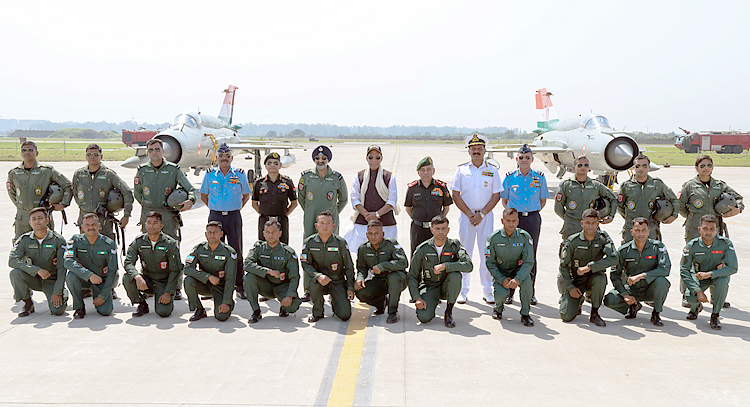INDIAN ARMED FORCES CHIEFS ON OUR RELENTLESS AND FOCUSED PUBLISHING EFFORTS

The insightful articles, inspiring narrations and analytical perspectives presented by the Editorial Team, establish an alluring connect with the reader. My compliments and best wishes to SP Guide Publications.

"Over the past 60 years, the growth of SP Guide Publications has mirrored the rising stature of Indian Navy. Its well-researched and informative magazines on Defence and Aerospace sector have served to shape an educated opinion of our military personnel, policy makers and the public alike. I wish SP's Publication team continued success, fair winds and following seas in all future endeavour!"

Since, its inception in 1964, SP Guide Publications has consistently demonstrated commitment to high-quality journalism in the aerospace and defence sectors, earning a well-deserved reputation as Asia's largest media house in this domain. I wish SP Guide Publications continued success in its pursuit of excellence.
Repurposed Jet Swarms
India's retirement of the MiG-21 contrasts with China's innovative conversion of its legacy J-6 fighters into combat drones, underscoring the need for India's defence establishment to repurpose decommissioned aircraft to strengthen future air defence capabilities.
 |
The Author is Former Director General of Information Systems and A Special Forces Veteran, Indian Army |

After six decades of service as a legendary fighter aircraft of the Indian Air Force (IAF), the MiG-21 was given a final farewell on September 26, 2025. The farewell ceremony, held at Chandigarh Air Base, was attended by Defence Minister Rajnath Singh, Chief of Defence Staff (CDS) General Anil Chauhan, Chief of Air Staff (CAS) Air Chief Marshal A.P. Singh, and other dignitaries. The MiG-21 was first inducted into the IAF's fighter fleet in Chandigarh in the 1960s. Wing Commander Dilbagh Singh had led the first MiG-21 squadron in Chandigarh in 1963.
The MiG-21 had become the mainstay of the IAF for a long period of time. The fighter jet proved its mettle in multiple conflicts, including the 1965 and 1971 wars, and the 1999 Kargil Conflict.
The MiG-21 had become the mainstay of the IAF for a long period of time. After its first induction, the IAF procured over 870 MiG-21s to boost its overall combat prowess. A generation of pilots were trained on the MiG-21. The fighter jet proved its mettle in multiple conflicts, including the 1965 and 1971 wars, and the 1999 Kargil Conflict.

At the farewell ceremony, paratroopers from the Air Force's Akash Ganga Team first saluted the MiG-21 by jumping from an altitude of approximately 8,000 feet. Then the last six MiG-21 of IAF's 23 Squadron (nicknamed "Panthers") flew in two formations, forming a cloud-like formation. Air Chief Marshal A.P. Singh flew the last sortie of the Squadron with the call sign 'Badal 3'. Aerial combat scenes were displayed between Jaguar and MiG-21 aircraft.
On landing back, the six MiG-21s received a water cannon salute. With its final roar, the MiG-21 became a chapter in the history of India's air power. On this occasion, Defence Minister Rajnath Singh said that there have been many occasions when the MiG-21 has proven its decisive capability. Nothing is known about the final destination of the decommissioned MiG-21s. However, there is speculation that at least one MiG-21 will be positioned at the Air Force Museum in Delhi's Palam in the near future. Many of the retired jets would be headed to museums across the world, while unconfirmed reports indicate a few MiG-21s may be maintained in flying condition to be used as a ceremonial vintage squadron.
At the Changchun air show, China showcased a Soviet-era J-6 fighter jet turned into a drone that can be used for large-scale swarm attacks.
Here it is significant to note that at the Changchun air show, held from September 19 - 23 in Changchun City in northeast China, Jilin Province, China showcased a Soviet-era J-6 fighter jet turned into a drone that can be used for large-scale swarm attacks. According to analysts, the Peoples' Liberation Army (PLA) revealed a combat drone – converted from a retired 1950s J-6 fighter jet that could be used for a swarm attack in a potential conflict across the Taiwan Strait.

Appearance of this drone confirmed years of speculation that the PLA was trying to repurpose its legacy fleet of J-6s.China built thousands of the warplanes, based on the Soviet MiG-19, from the 1960s to the 1980s. A second-generation supersonic fighter jet, the J-6 has a maximum speed of Mach 1.3, much slower than China's most advanced fighter, the J-20, which can exceed Mach 2.0. The J-6 has a combat range of 700 km (435 miles) and can carry up to 250 kg (550 lbs) of munitions. China built thousands of J-6 fighter jets from the 1960s to the 1980s. After modification, they can now be used as strike aircraft or target drones in training, according to the display.
According to information accompanying the drone exhibit at the air show, the first unmanned J-6 took flight as early as 1995. Much of the old J-6 airframe has been incorporated into the drone design, making it fast and cheap to produce and expendable. The modification included the addition of extra weapon stations to increase capacity. The sheer number of J-6 drones would make them cost-effective for attrition warfare. The PLA is estimated to have around 3,000 of these fighter jets at its disposal.
Indian policy makers, the MoD and the IAF must take a cue with regard to our de-commissioned and to be retired aircraft; repurposing them for strike operations.
As a full-size fighter jet with minimal avionics, the J-6 also has the advantage of being less vulnerable to anti-drone systems such as electronic jammers or directed-energy weapons (DEWs); implying these drones can also be used as decoys to prompt conventional air defence radars to emit, revealing their location and frequency. That would then allow the PLA's electronic warfare systems or anti-radiation missiles to locate, jam or destroy the radar sites.

Former Taiwanese Lt General Shuai Hua-ming said on a television show, "I am not afraid of the Dongfeng (PLA's ballistic missiles), I am worried about this drone. Hundreds or even thousands of these aircraft could come in a swarm – that would be more terrifying than missiles." If not intercepted, the J-6 drones could be used to bomb high-value ground targets or even strike them, at supersonic speed in suicide attacks.
Indian policy makers, the Ministry of Defence (MoD) and the IAF must take a cue from the above, with regard to our de-commissioned/to be retired aircraft; repurposing them for strike operations, not just positioning them in museums and public places as show pieces. According to Group Captain Uttam Kumar Devnath, veteran IAF pilot, our Mirage 2000, Jaguar and MiG-29 fighter jets, which are already 40-50 years old, would be decommissioned 15 years from now.





